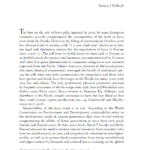Kava as a food, and who we have to thank.
After the previous announcement of how the FDA has accepted and ratified the codex definition of kava when mixed with water and strained, we should take a closer look at the Codex document itself, and how the email was obtained. Contained within, the codex addresses crucially important details related to quality, handling, packaging, food additives, contaminants, hygiene, labeling and testing, among others. The document lays the groundwork for a safe and more standardized kava industry. We’ll go over that, and we’ll dive into who we should thank.
The Codex definition of kava can be broken down into 7 specific sections which are:
- Scope: The Codex definition defines the scope and description of kava products, ensuring that only specific plant parts from Noble kava cultivars are used, which promotes the use of safe and high-quality raw kava plant materials. This would discourage the use of above ground portions such as stems and leaves, along with non-noble, non-beverage-grade kavas.
- Quality Factor Limits: Specifying essential composition and quality factors, including limits on moisture content, absence of adulteration, and freedom from contaminants such as pests, mold, soil, and foreign materials. These criteria help maintain product quality and safety by setting strict limits.
- Food Additives: The codex prohibits the use of food additives, which helps to preserve the natural composition of kava products and prevents potential health risks associated with additives. “Food Additives” are defined by the Codex & US FDA as “any substance that is intentionally added to food to achieve a specific technological purpose, such as preserving, coloring, or flavoring the food”. The FDA stipulates that GRAS ingredients like certain flavors are excluded from the legal definition of food additives and do not require the same pre-market FDA review and approval process that is required for food additives. The use of GRAS ingredients must still meet the same safety standards, but the FDA GRAS notification program for such ingredients is voluntary rather than mandatory.
- Contaminants and Pesticides: Kava products must align to within accepted levels of contaminants and pesticides to reassure that there are absolutely no potentially dangerous substances in the final kava product. Pesticides generally are not a problem for most kava producing nations, however with new locations growing kava, it continues to be important to maintain quality standards to provide a level playing-field for all stakeholders.
- Packaging, Storage & Prep: The codex standard, in section 3.6, provides clear guidelines for packaging, storing, and preparing kava to maintain quality, keep contamination risks as low as possible, and clearly ensure the consumers can use the products in a safe manner. This section also stipulates moisture content and storage temperature. This is extremely important to prevent bacteriological and mold growth.
- Labeling: The codex standard requires labels that inform consumers about the product’s origin, composition, and usage instructions. These requirements allow for the informed choices and safe use of kava. What we essentially do not want are instances where consumers mistakenly purchase kava products being unaware they had done so.
- Testing Methods: Referencing standardized methods of analysis for key quality parameters, such as absorbance of acetonic extracts and moisture content, which helps to ensure consistent product quality across the industry. The absorbance test uses UV light at the wavelength of 440nm, and is a method developed by Dr. Vincent Lebot to accurately quantify flavokavains and kavalactones. The moisture content test referenced is simply a method of testing moisture content as applied to sugars.
Overall, the codex provides a framework to ensure the safety, quality, and consistency of kava products. Crucial to everyone’s understanding, however, is how we arrived at this spot together. Many times we say it takes a team, but for this occasion, it took the determination, grit, and persistence of one man, Mr. Ed Johnston of Alia Point Nursery. Ed Johnston, on behalf of the International Kava Organization, and the Association for Hawaiian ‘Awa, fervently sought clarification regarding the FDA’s position on kava in relation to the food standards established by the Codex. It took him the better part of a year, and more than a dozen emails to get ahold of this document, and after several FOIA attempts, was ultimately successful. For this we want to say:
THANK YOU ED JOHNSTON (Association for Hawaiian ‘Awa, Legacy Director For International Kava Organization. Alia Point Nursery. Living Kava Relic. Father of Commercial Hawaiian ‘Awa). Thank you for your tenacity, your integrity, and your absolute love for this amazing cultural keystone species.
FAO/WHO Codex Alimentarius Commission. (2020). Proposed draft regional standard for kava products for use as a beverage when mixed with water (CX/CAC 20/43/4 Add.1 Rev.1). Joint FAO/WHO Food Standards Programme, Codex Alimentarius Commission, Forty-third Session. https://www.fao.org/fao-who-codexalimentarius/sh-proxy/en/?lnk=1&url=https%253A%252F%252Fworkspace.fao.org%252Fsites%252Fcodex%252FStandards%252FCXS%2B336R-2020%252FCXS_336Re.pdf
“Food Additives DB (GSFA Online).” n.d. Accessed March 7, 2024. https://www.fao.org/fao-who-codexalimentarius/codex-texts/dbs/gsfa/en/.
Center for Food Safety, and Applied Nutrition. 2024. “Understanding How the FDA Regulates Food Additives and GRAS Ingredients.” U.S. Food and Drug Administration. FDA. February 28, 2024. https://www.fda.gov/food/food-additives-and-gras-ingredients-information-consumers/understanding-how-fda-regulates-food-additives-and-gras-ingredients.




